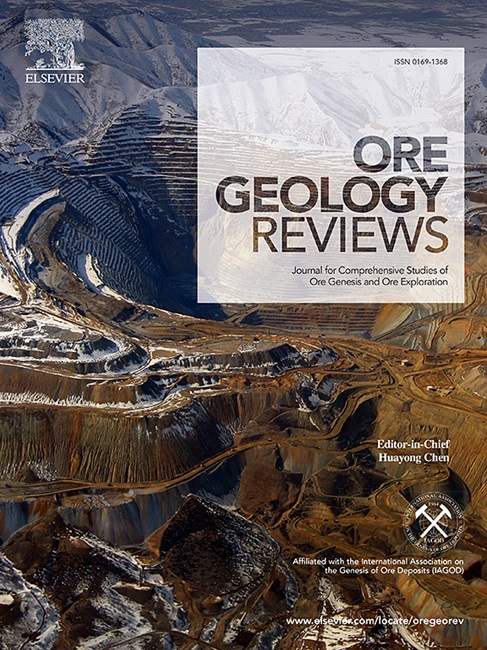Facies architecture, ore genesis (Zn-Pb-Cu) and structural evolution of the Paleoproterozoic Aijala–Metsämonttu area, SW Finland
IF 3.6
2区 地球科学
Q1 GEOLOGY
引用次数: 0
Abstract
A field-based study was conducted in the metamorphosed and deformed Aijala–Metsämonttu area within the Orijärvi formation, part of the Uusimaa belt (1.9–1.88 Ga) in southern Finland. The study aimed to enhance understanding of the regional facies architecture and tectonic framework. Volcanic facies analysis, lithogeochemistry, and sulfide textural interpretations were utilized, allowing us to reassess the previously suggested exhalative model of the Metsämonttu sulfide deposit (1.5 Mt at 3.5 wt% Zn, 0.8 wt% Pb, 0.3 wt% Cu, 13.2 wt% S, 25 g/t Ag, and 1.4 g/t Au, production 1952–1974) to assist regional exploration.
Regionally, D1 thrusting was the primary significant structural event, associated with the common occurrence of both L–S and L-tectonites. D2 represents nearly orthogonal shortening, producing upright to steeply inclined F2 folds. The Aijala–Metsämonttu area is dominated by a felsic volcaniclastic lithofacies association, originating from voluminous silicic magmas. The region features both primary and redeposited rhyolitic pyroclastic deposits intercalated with carbonates and iron formations, alongside subordinate dacite-rhyolite complexes and submarine mafic fissure vents. Geochemically, the rocks exhibit subalkaline to transitional magmatic affinities, indicating a volcanic arc system likely associated with early-stage rifting, extensional basin formation in an intra-arc or back-arc setting. The Metsämonttu succession primarily consists of resedimented syn-eruptive volcaniclastic deposits intercalated with sedimentary facies. The Metsämonttu sulfide deposit, hosted by metavolcanic rocks, marble, and skarn, contains semimassive to stringer-style polymetallic sulfides, controlled by stretching along D1 recumbent fold axes (L-tectonite) and subsequent vertical stretching along D2 limbs. The mineralization is considered a metamorphosed subseafloor carbonate replacement deposit, hosted within permeable polymict dacitic fiamme-lithic pumiceous breccia.

芬兰西南部Aijala-Metsämonttu地区古元古代相构型、矿床成因(Zn-Pb-Cu)及构造演化
在芬兰南部Uusimaa带(1.9-1.88 Ga)的Orijärvi组内的变质变形Aijala-Metsämonttu区进行了野外研究。研究旨在加深对区域相构型和构造格架的认识。利用火山相分析、岩石地球化学和硫化物结构解释,使我们能够重新评估先前提出的Metsämonttu硫化物矿床(1.5 Mt,含3.5 wt% Zn、0.8 wt% Pb、0.3 wt% Cu、13.2 wt% S、25 g/t Ag和1.4 g/t Au,生产1952-1974)的喷发模型,以协助区域勘探。从区域上看,D1逆冲是主要的重大构造事件,与L-S和l -构造岩的普遍存在有关。D2表示近正交缩短,产生直立到陡峭倾斜的F2褶皱。Aijala-Metsämonttu地区主要为长英质火山碎屑岩相组合,起源于大量的硅质岩浆。区内既有原生流纹岩,也有再沉积流纹岩火山碎屑矿床,与碳酸盐岩和铁地层穿插,并伴有次级英安岩流纹岩杂岩和海底基性裂缝喷口。从地球化学上看,岩石表现出亚碱性-过渡性岩浆的亲缘关系,表明其火山岩体系可能与早期裂陷、弧内或弧后环境下的伸展盆地形成有关。Metsämonttu序列主要由复沉积的同喷发型火山碎屑沉积与沉积相夹层组成。Metsämonttu硫化物矿床由变质火山岩、大理岩和矽卡岩等组成,含半块状至弦状多金属硫化物,受沿D1斜卧褶皱轴(l -构造岩)的拉伸和随后沿D2支的垂直拉伸控制。矿化被认为是变质的海底碳酸盐替代矿床,赋存于可渗透的多晶英灰质时岩屑浮石角砾岩中。
本文章由计算机程序翻译,如有差异,请以英文原文为准。
求助全文
约1分钟内获得全文
求助全文
来源期刊

Ore Geology Reviews
地学-地质学
CiteScore
6.50
自引率
27.30%
发文量
546
审稿时长
22.9 weeks
期刊介绍:
Ore Geology Reviews aims to familiarize all earth scientists with recent advances in a number of interconnected disciplines related to the study of, and search for, ore deposits. The reviews range from brief to longer contributions, but the journal preferentially publishes manuscripts that fill the niche between the commonly shorter journal articles and the comprehensive book coverages, and thus has a special appeal to many authors and readers.
 求助内容:
求助内容: 应助结果提醒方式:
应助结果提醒方式:


